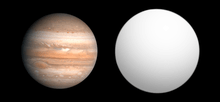OGLE-TR-113b
OGLE-TR-113b is an extrasolar planet orbiting the star OGLE-TR-113.
 Size comparison of OGLE-TR-113b with Jupiter | |
| Discovery | |
|---|---|
| Discovered by | Konacki et al.[1] |
| Discovery site | |
| Discovery date | transit found in 2002, proved to be a planet on 14 April 2004[1] |
| Transit[1] | |
| Orbital characteristics | |
| 0.0229 ± 0.0002 AU (3,426,000 ± 30,000 km)[2] | |
| Eccentricity | 0[2] |
| 1.4324757 ± 0.0000013[2] d | |
| Inclination | 88.8[2] |
| Star | OGLE-TR-113 |
| Physical characteristics | |
Mean radius | 1.09 ±0.03 RJ |
| Mass | 1.32 ±0.19 MJ |
In 2002 the Optical Gravitational Lensing Experiment (OGLE) detected periodic dimming in the star's light curve indicating a transiting, planetary-sized object.[3] Since low-mass red dwarfs and brown dwarfs may mimic a planet, radial velocity measurements were necessary to calculate the mass of the body. In 2004, the object was proved to be a new transiting extrasolar planet.[1]
The planet has a mass 1.32 times that of Jupiter. Since the planet's inclination is known, the value is exact. It orbits the star (OGLE-TR-113) in an extremely close orbit, even closer than the famous planets 51 Pegasi b and HD 209458 b. The planet races around the star every 1.43 days. The radius of the planet is only 9% larger than Jupiter's, despite the heating effect by the star. Planets of its kind are sometimes called "super-hot Jupiters".[2]
See also
- OGLE-TR-132b
- List of extrasolar planets
- OGLE-TR-10b
- OGLE-TR-111b
- OGLE-TR-56b
- OGLE2-TR-L9b
References
- Konacki, Maciej; et al. (2004). "The Transiting Extrasolar Giant Planet around the Star OGLE-TR-113". The Astrophysical Journal Letters. 609 (1): L37–L40. arXiv:astro-ph/0404541. Bibcode:2004ApJ...609L..37K. doi:10.1086/422600.
- Gillon, M.; et al. (2006). "High accuracy transit photometry of the planet OGLE-TR-113b with a new deconvolution-based method". Astronomy and Astrophysics. 459 (1): 249–255. arXiv:astro-ph/0606395. Bibcode:2006A&A...459..249G. doi:10.1051/0004-6361:20065844.
- Udalski, A.; et al. (2002). "The Optical Gravitational Lensing Experiment. Planetary and Low-Luminosity Object Transits in the Carina Fields of the Galactic Disk". Acta Astronomica. 52 (4): 317–359. arXiv:astro-ph/0301210. Bibcode:2002AcA....52..317U.
External links
![]()
- "OGLE-TR-113 b". Exoplanets. Archived from the original on 2012-04-01. Retrieved 2010-01-20.